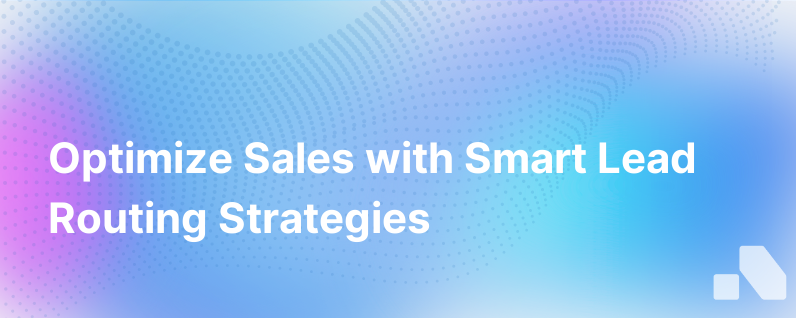Lead Routing
Published on August 21, 2023 by Sawyer Middeleer
In the rapidly evolving world of B2B sales and marketing, the competition for attracting and capturing leads is fiercer than ever. The ability to quickly convert high-quality leads into opportunities can often be the differentiator between a thriving business and one that lags behind. One critical process that can significantly affect this conversion is lead routing—ensuring that every sales-ready lead gets to the right sales rep, at the right time.
Understanding Lead Routing
Lead routing is the process within a business’s sales operations that involves distributing leads to salespersons, account managers, or other reps. It sounds straightforward on paper, but the logistics can be quite complicated. The goal of lead routing is to maximize efficiency and minimize response times, greatly increasing the chances of converting leads. Knowing how to manage and route leads effectively is integral to the success of any sales organization.
Why Lead Routing is Crucial for Sales Efficiency
Effective lead routing impacts key areas of the sales process, including:
- Lead Response Time: The speed at which a lead is responded to can drastically increase the likelihood of a conversion. According to a Harvard Business Review study, firms that contacted potential leads within an hour of receiving a query were nearly seven times as likely to qualify the lead as those who contacted the customer an hour later—and more than 60 times as likely as companies that waited 24 hours or longer.
- Sales Productivity: Properly routed leads ensure sales reps work on leads best suited to their expertise and current workload, preventing potential overwhelm and wasted time on ill-fitting leads.
- Customer Experience: Customers or prospects often benefit from improved interactions with sales reps who are specialized in their particular areas of need or interest. This also helps in building trust and credibility.
Fundamentals of Lead Routing
Lead routing is not simply about dispersing leads based on geography or who's next in line to take a lead. There are several criteria that can guide intelligent lead routing, such as:
- Geography: Routing leads based on the prospect’s location to sales reps who manage those territories.
- Industry/Vertical: Assigning leads to sales reps who have specialized knowledge in that specific industry.
- Lead Score: Using marketing automation to score leads and route high-scoring (i.e., sales-ready) leads to the appropriate reps.
- Round Robin: Distributing leads equally among sales reps to ensure a balanced workload.
- Company Size: Allocating leads to reps according to their experience with small businesses, mid-market companies, or enterprise accounts.
- Behavioral Data: Routing leads based on the prospect's previous interactions with your company—such as content downloads, webinar attendance, and product page views—to a rep with a relevant area of expertise.
Lead Routing Best Practices for Maximizing Sales
To make the most of your lead routing process, consider these best practices:
- Automation: Automate your lead routing process to ensure timely and accurate distribution. Technology can handle sophisticated routing logic far more efficiently than manual processing.
- Continuous Analysis: Regularly evaluate the existing lead routing process and make adjustments as needed. Your business evolves, and so should your lead routing strategy.
- Ensure Data Quality: An efficient lead routing system relies on high-quality data. Regularly cleanse and validate lead data to avoid inefficiencies like routing errors or lead loss.
- Align Sales and Marketing: Make sure that the Marketing team’s lead qualification criteria are transparent and well understood by Sales to ensure a smooth handoff.
- Performance Analytics: Use analytics to measure lead response times, conversion rates, and sales rep performance to continue refining your lead routing strategy.
Implementing a Lead Routing System
When setting up a lead routing system, here are the steps to consider:
- Define Your Strategy: Clearly identify what attributes—such as industry expertise or geographical location—will determine how leads are routed.
- Select the Right Tools: Choose a CRM and any necessary marketing automation tools that support complex lead routing logic.
- Set Up Routing Rules: Configure your CRM and sales automation platforms to execute your desired lead routing strategy effectively.
- Train Your Team: Make sure all team members understand the lead routing process and know what to do once a lead is assigned to them.
- Monitor and Improve: Continuously monitor the effectiveness of your lead routing process and make iterative improvements.
The Role of Technology in Lead Routing
Technological advancements have significantly improved processes surrounding lead routing. Modern CRM systems and automation platforms can be used in implementing intricate lead routing logic. These systems can even incorporate artificial intelligence to predict the best match between a lead and a sales rep, potentially increasing the chances of converting the lead.
Furthermore, integrations with communication tools like email and SMS can alert sales reps in real-time when a lead has been routed to them, reducing response times and improving lead management.
Conclusion
Gone are the days of manually sifting through leads and haphazardly assigning them to sales reps. Today’s competitive landscape requires a sophisticated, data-driven approach to lead routing that gets leads into the right hands quickly.
In the end, no matter how seamless your lead routing process, it remains vital to maintain a human touch in the sales experience. Even the most sophisticated systems can't replace the importance of personal relationships and the nuanced understanding of a knowledgeable sales professional.
Done well, lead routing can be the crucial link between lead generation and sales success, ensuring that leads are not only nurtured but also effectively converted into revenue-generating opportunities. For companies like Aomni, where cultivating and capitalizing on B2B relationships is at the core, refining the lead routing process is a continuous investment in future growth.